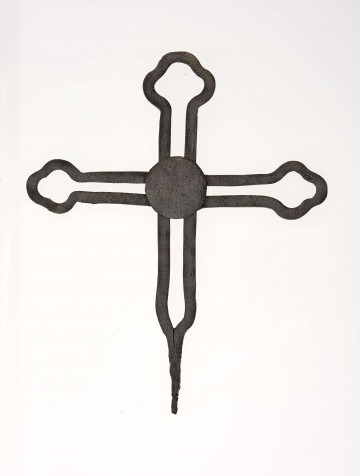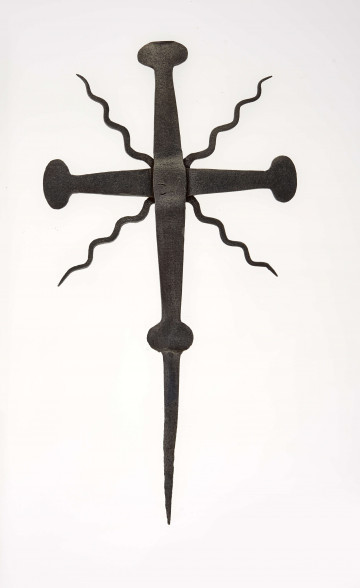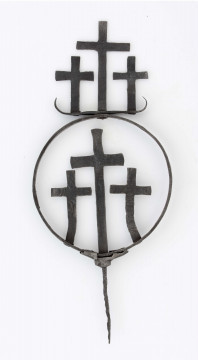
Cross
1901 — 1920
National Museum in Lublin
Part of the collection: Folk craft of the Lublin Region (19th/20th c.)
The place of origin of this exhibit from the first half of the 20th century, acquired for the Museum before the Second World War, is not established. The soundbox was made of pinewood and other elements of soft light wood by carpentry technique, with metal and leather elements also added. The instrument consists of a soundbox, a case, a crank with a wheel, four strings, and four pegs for winding the strings. The length of the box is 72 cm, the height of its back is 6.5 cm, and the width at both ends reaches 27.5 cm. The instrument is hung on a thong or string around the neck so that the lower lid rests against the chest. It can also be used in a sitting position and held on the knees. The player presses the keys with the left hand from the bottom while the right hand turns the crank. The crank is connected to a wheel that, as it turns, rubs the strings just like a bow in other instruments. When a key is pressed, an internal pin touches all four strings and shortens their length. Thus, if the string vibrates (the vibration of the strings sets the wheel in motion), a low or high tone is obtained by lengthening or shortening.
The hurdy-gurdy was an instrument popularly used in the Middle Ages and the Renaissance in the upper classes to accompany bards. From there, it found its way to the countryside, where it was used mainly by wandering beggars, called lyrists. They roamed from village to village throughout eastern Poland (today's Belarus and Ukraine)where they played for a living at churches, cemeteries, or church fairs. In the inter-war period, this instrument was also used by folk musicians in the Rzeszów and Sandomierz areas. After World War I, it practically went out of use. Nowadays, it is chiefly folk musicians and philharmonic musicians who appreciate its versatile possibilities.
Author / creator
Dimensions
cały obiekt: height: 26 cm, width: 74 cm
Object type
a musical instrument
Technique
carpentry techniques
Material
pine wood, metal
Creation time / dating
Creation / finding place
Owner
The National Museum in Lublin
Identification number
Location / status

1901 — 1920
National Museum in Lublin

1890 — 1910
National Museum in Lublin

1863 — 1868
National Museum in Lublin
DISCOVER this TOPIC
Castle Museum in Łańcut
DISCOVER this PATH
Educational path